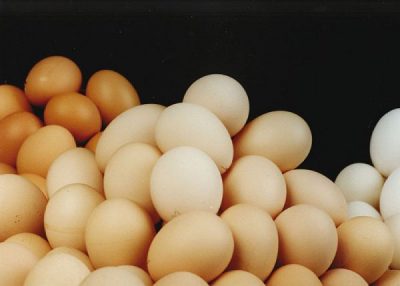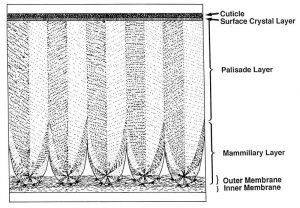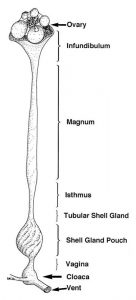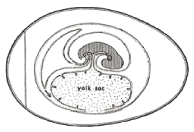The Avian Egg
The Avian Egg
Humans and other animals have used eggs as a food source for millennia. Eggs are an important and well-balanced source of essential nutrients. Bird eggs (for example, chicken eggs) consist of a protective eggshell, albumen (egg white), and vitellus (egg yolk), contained within various thin membranes.
Egg yolks and whole eggs are a good source of protein and choline. For this reason, the United States Department of Agriculture (USDA) categorises eggs as Meat. Chicken eggs that are produced commercially for eating have not been fertilised by a rooster and, therefore, cannot develop into embryo and finally a chick. It is possible to enrich table eggs with minerals (e.g. iron and iodine), antioxidants (e.g. selenium, vitamin E) or omega-3 fatty acids and vitamins, by adding these as components of the hen diet. There are some enriched eggs available in Australia but this represents a niche market for eggs, as only a small percentage of consumers purchase such eggs.
Chicken Egg biology
Nature’s role for the egg is as an incubation chamber for the developing chick. For an egg to develop into a chick, it should have been fertilised by a rooster (also called a cockerel). Once the fertilised egg is laid, it must be kept warm and this may be done either naturally by the hen sitting on the egg, or artificially by placing the egg into an incubator.
The egg contains all the nutrients that the developing chick needs during the three weeks of incubation period and also for the first couple of days after hatch. Water vapour and gases such as oxygen and carbon dioxide are able to move across the egg shell through small openings called pores. The developing chick starts off as a single fertilised cell on the surface of the yolk and progressively grows, using up the yolk, some of the albumen and some calcium from the inside of the egg shell. In the final stages of development, the chick takes up the last bits of yolk into its own digestive system.

Eggs vary in colour
The production of the bird egg consists of a series of steps that occur as the egg enters and passes along the hen’s reproductive tract (oviduct). The yolk of the egg enters the top of the oviduct and passes into the infundibulum where it spends about 15 minutes. A membrane is added around the yolk and, if the hen has been inseminated, fertilisation occurs in this section of the oviduct.
The yolk then spends about three hours in the magnum where the egg white is formed and then one hour in the isthmus where the shell membrane is laid down. The main part of the egg shell is formed in the tubular shell gland and the shell gland pouch which takes about 20 hours. The egg shell is sometimes referred to as a bio-ceramic because it is made up of calcium carbonate with an organic matrix running through it.
 |
 |
 |
 |
| Cross-sectional diagram of an avian egg | Diagrammatic side view of the eggshell | Ovary and oviduct | Cross-section of an egg as an incubator |
Composition of the chicken egg
The physical composition on the avian egg can be seen in Table 1, below. The egg is comprised of 32-35% yolk, 52-58% albumen and 9-14% shell. Composition of the albumen and yolk are further presented in the image gallery above (Cross-sectional diagram of an avian egg).
| Egg components | ||
|---|---|---|
| Nutrient | Albumen | Yolk |
| Protein | 9.7 – 10.6 | 15.7 – 16.6 |
| Lipid | 0.03 | 31.8 – 35.5 |
| Carbohydrate | 0.4 – 0.9 | 0.2 – 1.0 |
| Water | 84.3 – 88.8 | 48 |
| Element | ||
| Sulphur | 0.195 | 0.016 |
| Potassium | 0.145 – 0.167 | 0.112 – 0.360 |
| Sodium | 0.161 – 0.169 | 0.070 – 0.093 |
| Phosphorus | 0.018 | 0.543 – 0.980 |
| Calcium | 0.008 – 0.02 | 0.121 – 0.262 |
| Magnesium | 0.009 | 0.032 – 0.128 |
| Iron | 0.0009 | 0.0053 – 0.011 |
Adapted from Li-Chan, ECY, Powrie, WD and Nakai, S (1995) The chemistry of eggs and egg products, In Egg Science and Technology, WJ Stadelman and OJ Cotterill (Eds), The Haworth Press Inc, New York.
Yolk
A raw egg yolk provides the lipids and proteins that are required for embryonic growth. The yolk is comprised of 33% lipid, 17% protein, and small amounts of minerals, vitamins and carbohydrates. The lipid composition of the egg yolk consists of various lipids and fatty acids, of which the triglycerides
represent more than two third of the total lipid content (Table 2). Yolk pigmentation is mainly a result from the direct transfer of pigments from feed and/or feed additives, but there is also some endogenous pigment used to colour the yolk. It has been speculated that this endogenous pigment is from body tissues, but the mechanism of storage or release of the pigment is not fully understood.
Table 2. Lipid composition of the egg yolk
| Lipid Composition | Percentage |
|---|---|
| Triglycerides | 63 |
| Phospholipids | 31 |
| Cholesterol | 4 |
| Other (including fat soluble vitamins) | 2 |
| Fatty Acid Composition | Percentage |
| Saturated fatty acids | 35 – 45 |
| Unsaturated fatty acids | 55 – 65 |
| Monounsaturated fatty acids | 35 – 50 |
| Linoleic acid | 10 – 20 |
| Polyunsaturated fatty acids | 3 – 5 |
Adapted from Larbier, M and Leclercq, B (1994) Nutrition and feeding of poultry, Nottingham University Press, Nottingham.

A raw egg yolk
Egg yolk colour

In Australia, people like a yolk that is bright yellow-orange. Europeans like their egg yolks even darker whereas, in North America, paler yolks are the norm. Fifty years ago, most people had a few chickens in the backyard, even if they lived in a city. These chickens would often be fed only on table scraps and what they could scavenge in the back yard. They would eat many types of plants which are a source of a group of pigments known as carotenoids. These get laid down in the egg yolk and give it a bright yellow-orange colour.
As far as is known, these pigments do not contribute to the nutritional value of the egg. This is because the pigments (carotenoids) are the precursor of vitamin A, however, in the human body, they are not converted to vitamin A. When egg production became more intensive and laying hens were fed a complete diet, egg producers added carotenoids to the poultry feed to produce the bright-coloured yolks that people were accustomed to from the back-yard hen days. In the commercial egg industry in Australia, most egg producers use a synthetic form of carotenoid. It is possible to obtain natural pigments, which are produced from plant products such as marigold flower petals or red capsicums, but these are more expensive than the synthetic pigments. The grains fed to chickens contain some carotenoids particularly from corn (maize) which is commonly used in poultry diets in North America. In commercial free-range production, it is usual to add carotenoids to the feed also.
Albumen
The albumen consists chiefly of proteins, including ovalbumin, ovotransferrin, ovomucoid, ovoglobulin, lysozyme and ovomucin (See Table 3). The various roles of these proteins include inhibition of protein break down and maintenance of the viscosity of the thick albumen. The function of the albumen is to protect the embryo (or yolk) from attack by microorganisms and also to serve as a source of water, protein and minerals for the embryo.
There are four distinct layers of albumen that have surrounded the yolk by the time the egg is laid. The innermost layer is known as the chalaziferous layer (attached to the yolk) comprising 2.7% of the total albumen, followed by the inner thin layer (16% total albumen), the middle thick layer (50% total albumen) and the outer thin layer (25% total albumen). The majority of the modifications to the albumen occurs during the first 6-8 hours (2-3 hours in modern layers), after which the developing egg enters the shell gland and undergoes a process called ‘plumping’. During this process, a uterine secretion, which is mostly water with some minerals such as sodium, calcium and potassium, is pumped into the egg.

